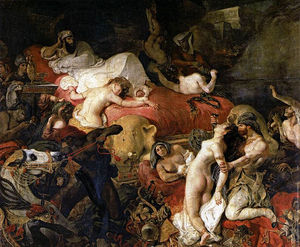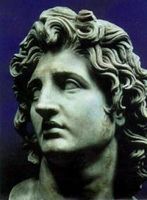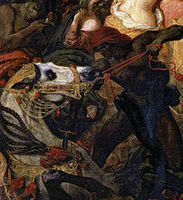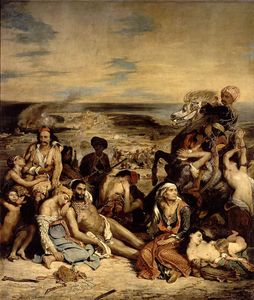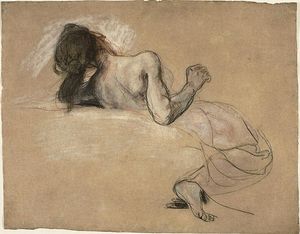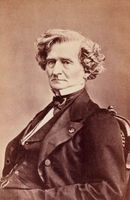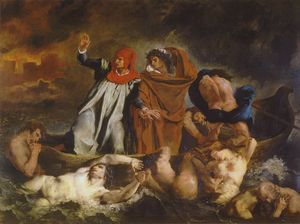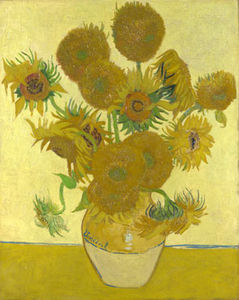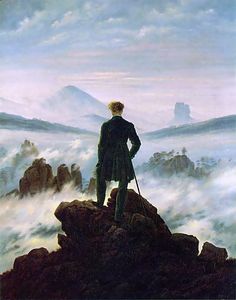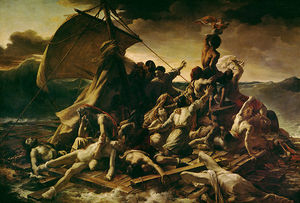The Death of Sardanapalus
- Date of Creation:
- 1827
- Height (cm):
- 392.00
- Length (cm):
- 496.00
- Medium:
- Oil
- Support:
- Canvas
- Subject:
- Scenery
- Framed:
- Yes
- Art Movement:
- Romanticism
- Created by:
- Current Location:
- Paris, France
- Displayed at:
- Musée du Louvre
- Owner:
- Musée du Louvre
- The Death of Sardanapalus Page's Content
- Story / Theme
- Inspirations for the Work
- Analysis
- Critical Reception
- Related Paintings
- Artist
- Art Period
- Bibliography
The Death of Sardanapalus Story / Theme
The story of the Assyrian ruler, Sardanapalus, is a tragic one and so it's no wonder this tale attracted the warped interest of Eugene Delacroix. According to the story, Sardanapalus was the last king of Nineveh, a city in between the Mediterranean Sea and the Caspian Sea (present day Iraq).
He decided to take matters into his own hands after learning that his city was under attack by a rebellious enemy group. Instead of facing a humiliating defeat, Sardanapalus decided he himself would destroy his prized possessions.
His concubines - including his favorite Myrrha, his horses, his slaves would all be burned and destroyed. His knowing that he also would be burned on the funeral pyre makes his apathetic reaction all the more alarming. Legend has it the king died 876 BC.
Eugene Delacroix also found inspiration from literary work and The Death of Sardanapalus was also based on Lord Byron's 1821 tragedy Sardanapalus. It is believed that Byron's story was influenced by the Greek historian Diodorus (first century CE).
The Death of Sardanapalus Inspirations for the Work
Lord Byron's Sardanapalus:
Think'st thou there is no tyranny but that
Of blood and chains? The despotism of vice--
The weakness and the wickedness of luxury--
The negligence--the apathy--the evils
Of sensual sloth--produces ten thousand tyrants,
Whose delegated cruelty surpasses
The worst acts of one energetic master,
However harsh and hard in his own bearing.
(act I, sc. 2)-

The Death of Sardanapalus
Although Lord Byron's 1821 tragedy Sardanapalus was Delacroix's main inspiration, he does not follow the text precisely but instead adapted the theme according to his own imagination. In true Delacroix nature, the artist depicted the scene of the last hour in a much more destructive manner than Byron's poem.
Delacroix adds more people to the scene increasing the magnitude of disaster. He paints the ancient king surrounded by chaos; he has just ordered the death of his women, slaves, horses and most treasured concubine after learning of the defeat of his army. He would much rather destroy his own most valuable possessions than have left them in the hands of his enemies.
This scene from the Orient was painted before Delacroix traveled there himself. His inspiration came as a result of Napoleon's victory in Egypt. The booty brought back to Europe from Egypt inspired some of the objects found in the painting; the Egyptian winged sun and the Egyptian-styled hood worn by the Moors.
Other elements, including the cupbearer's Indian turban and the elephant decorations, were inspired by India. Delacroix's goal here was to be as non-European as possible and though this painting gives a sense of the Orient, the artist had yet to perfect the theme.
In The Death of Sardanapalus the king faces his demise with an apathetic expression amidst the corpses strewn across his lavish room. His eyes remain expressionless while his servants fulfill his orders and continue to kill his concubines and horses.
Such a scene of chaos and murder recalls the intensity first seen in The Massacres at Chios; Greek Families Awaiting Death or Slavery (see Related Paintings below).
The Death of Sardanapalus Analysis
The composition of The Death of Sardanapalus was executed in the new vignette style. Delacroix created the focus of the image in the center of the canvas, painting the light and most bright colors in the same spot. His brushstroke ensures that the painting is very detailed.
Composition:
Aside from the completely Oriental subject matter, Delacroix continued to rebel against the more typical European style of painting typically seen during his day.
As it was common for paintings to display balance and order, Delacroix decided to paint in the vignette style which called for a strong focus in the center as the image becomes less defined at the edges.
The focus of The Death of Sardanapalus exists at the foot of the bed, where the dead concubine lays across the soft fabric while another is being stabbed by the king's servant. The details around this part of the scene are less detailed and darker.
Tone elicited:
What attracted Delacroix to the story of Sardanapalus was the tragedy it possessed. He created chaos by adding more dead bodies and murders than the original texts suggests. He intended to evoke confusion. The disarray of this oriental scene was a direct contrast to the orderly world of the Europeans.
Brushstrokes:
Classically trained, Delacroix was accustomed to paying close attention to the detail of the line. As his style evolved his brushstrokes got thicker and quicker, but in Sardanapalus they remain for the most part tight and precise.
Color palette:
The reds and yellows in this image jump off the canvas, only making the scene all the more chaotic. These bright colors are delicately placed in the center of the canvas, where all the action is taking place.
Use of light:
Delacroix uses intense lighting to employ the vignette style. The sun shines at the precise moment of the chaos at the center of the canvas. The freshly murdered concubine and the concubine being slaughtered are directly illuminated in comparison to the destruction that surrounds them.
There seems to be a foggy haze over the rest of the corpses in the painting and they recede into the background. Even the king himself, in his disdainful pose, is slightly hidden in the shadows. Delacroix chose to direct attention to the most hectic and disturbing part of the scene.
The Death of Sardanapalus Critical Reception
The Death of Sardanapalus incorporates much more than the death of the ancient king. Delacroix displays a violent scene of corpses. Both concubines and horses struggle for their lives' against the attacks of the King's servants.
Critics of the artist's day found this expression appalling but as time passed they began to appreciate the work for its true genius and unique approach to color.
Contemporary reception:
The death and lust dripping from this canvas was considered barbaric by many of the critics. The artist's fascination with violence was not shared by his viewers, so much so that his piece was not on public display again until many years after its first exhibition.
Critics were unfamiliar with the vignette style and they also found the content unfavorable. As the nude woman struggling for her life is in the center of the canvas, the impact was too violent for many viewers.
Post-humous reception:
Once The Death of Sardanapalus was re-exhibited and after the artist's death, critics found the exotic colors and the composition shocking, but in a more pleasing manner. This painting went on to inspire many artists after Delacroix's death.
Modern day reception:
Modern day critics recognize The Death of Sardanapalus as one of Delacroix's masterpieces. They admire and praise his inventiveness, his courage to practice the new vignette style, and of course they recognize his color effects as nothing short of genius.
The Death of Sardanapalus Related Paintings
The Death of Sardanapalus Artist
Eugene Delacroix was 29 years old when he painted The Death of Sardanapalus. By this time he had already received attention after exhibiting Dante and Virgil in Hell at the Salon of 1822 and the Massacre at Chios at the Salon of 1824.
Like his earlier paintings, Delacroix continued to paint dramatic and violent scenes with an explosive approach to color that had never been seen before.
The Death of Sardanapalus is a prime example of Delacroix fascination with the terrible. He continued to paint such scenes for the remainder of his life.
This painting seems chaotic up close but when the viewer steps back his genius appears. The order of color, white, yellow, and red take the eye from left to right and from top to bottom. This technique is known to have inspired the Impressionist movement.
Known as a "master of color," Delacroix became a pupil of the English Romantic landscapists and extracted from their techniques, to develop a unique and memorable approach to color. The impact of literature and both historical and contemporary events, coupled with his innate artistic technique created an explosive viewing experience on canvas.
Delacroix's work changed the art world forever and his technique had a lasting impact on the Impressionist and Post-Impressionist movements such as van Gogh and Cezanne.
Today, he is remembered as one of the world's most influential French Romantic painters and his expertise and genius is fully recognized and appreciated by modern day art critics.
The Death of Sardanapalus Art Period
Romanticism is sometimes viewed as a reaction to its more serious predecessor, the Neoclassical movement. As Neoclassical artists focused on properly accounting history through close attention to detail, Romantic artists flirted with themes of man's self glorification, man's part in nature, divinity found in nature, and emotion.
Romanticism emphasizes the individual sense of self, creativity, imagination, and the value of art to make a statement. This emphasis on the individual is reflected in the ideas of self-realization through the act of contemplating nature.
There is the idea that the individual can only directly understand nature, free from society. Peace and salvation come through the individual rather than through political movements.
Romantic painters like Delacroix were part of a complex multimedia philosophical movement, involving the literary, visual, and intellectual arts.
Eugene Delacroix fine-tuned Romanticism, incorporating the influences of great masters such as Michelangelo and Peter Paul Rubens. He developed his own personal style, with an affinity for showing pain and suffering in his work through brightly colored canvases.
The Death of Sardanapalus Bibliography
To find out more about Delacroix and his work please refer to the recommended reading list below.
• Bussy, Dorothy. Eugene Delacroix. BiblioBazaar, 2009
• Gombrich, E. H. The Story of Art. Phaidon Press Limited, 1995
• Jobert, Barthélémy. Delacroix. Princeton University Press, 1997
• Johnson, Dorothy. David to Delacroix: The Rise of Romantic Mythology (Bettie Allison Rand Lectures in Art History). The University of North Carolina Press, 2011
• Johnson, Lee. Delacroix. New York Press, 1963
• Kauffman, Jean-Paul. Wrestling with the Angel: The Mystery of Delacroix's Mural. The Harvill Press, 2003
• Noon, Patrick, et al. Crossing the Channel: British and French Painting in the Age of Romanticism. Tate Publishing, 2003
• Prideaux, Tom. The World of Delacroix: 1798-1863. Time Life Education, 1966

